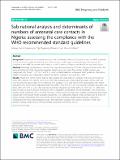Files in this item
Sub-national analysis and determinants of numbers of antenatal care contacts in Nigeria : assessing the compliance with the WHO recommended standard guidelines
Item metadata
| dc.contributor.author | Fagbamigbe, Adeniyi Francis | |
| dc.contributor.author | Olaseinde, Olugbenga | |
| dc.contributor.author | Setlhare, Vincent | |
| dc.date.accessioned | 2021-05-27T15:30:11Z | |
| dc.date.available | 2021-05-27T15:30:11Z | |
| dc.date.issued | 2021-05-25 | |
| dc.identifier | 274387302 | |
| dc.identifier | c8eaa55d-38c7-4d28-a137-fe9aecddac5c | |
| dc.identifier | 85106870678 | |
| dc.identifier | 000657690400002 | |
| dc.identifier.citation | Fagbamigbe , A F , Olaseinde , O & Setlhare , V 2021 , ' Sub-national analysis and determinants of numbers of antenatal care contacts in Nigeria : assessing the compliance with the WHO recommended standard guidelines ' , BMC Pregnancy and Childbirth , vol. 21 , 402 . https://doi.org/10.1186/s12884-021-03837-y | en |
| dc.identifier.issn | 1471-2393 | |
| dc.identifier.other | crossref: 10.1186/s12884-021-03837-y | |
| dc.identifier.uri | https://hdl.handle.net/10023/23265 | |
| dc.description.abstract | Background: Nigeria has unimpressive maternal and child health indicators. Compliance with the WHO guidelines on the minimum number of antenatal care (ANC) contacts could improve these indicators. We assessed the compliance with WHO recommended standards on ANC contacts in Nigeria and identify the associated factors. Methods: Nationally representative cross-sectional data during pregnancy of 21,785 most recent births within five years preceding the 2018 Nigeria Demographic Health Survey was used. The number of ANC contacts was categorised into “None”, “1–3”, “4–7” and “8 or more” contacts based on subsequent WHO guidelines. Descriptive statistics, bivariable and multivariable multinomial logistic regression was used at p = 0.05. Results: About 25 % of the women had no ANC contact, 58 % had at least 4 contacts while only 20 % had 8 or more ANC contacts. The highest rate of 8 or more ANC contacts was in Osun (80.2 %), Lagos (76.8 %), and Imo (72.0 %) while the lowest rates were in Kebbi (0.2 %), Zamfara (1.1 %) and Yobe (1.3 %). Respondents with higher education were twelve times (adjusted relative risk (aRR): 12.46, 95 % CI: 7.33–21.2), having secondary education was thrice (aRR: 2.91, 95 % CI: 2.35–3.60), and having primary education was twice (aRR: 2.17, 95 % CI: 1.77–2.66) more likely to make at least 8 contacts than those with no education. Respondents from households in the richest and middle wealth categories were 129 and 67 % more likely to make 8 or more ANC contacts compared to those from households in the lowest wealth category respectively. The likelihood of making 8 ANC contacts was 89 and 47 % higher among respondents from communities in the least and middle disadvantaged groups, respectively, compared to the most disadvantaged group. Other significant variables were spouse education, health care decision making, media access, ethnicity, religion, and other community factors. Conclusions: Compliance with WHO guidelines on the minimum number of ANC contacts in Nigeria is poor. Thus, Nigeria has a long walk to attaining sustainable development goal’s targets on child and maternal health. We recommend that the maternal and child health programmers should review existing policies and develop new policies to adopt, implement and tackle the challenges of adherence to the WHO recommended minimum of 8 ANC contacts. Women's education, socioeconomic status and adequate mobilization of families should be prioritized. There is a need for urgent intervention to narrow the identified inequalities and substantial disparities in the characteristics of pregnant women across the regions and states | |
| dc.format.extent | 19 | |
| dc.format.extent | 1509675 | |
| dc.language.iso | eng | |
| dc.relation.ispartof | BMC Pregnancy and Childbirth | en |
| dc.subject | Antenatal care | en |
| dc.subject | Nigeria | en |
| dc.subject | WHO guidelines | en |
| dc.subject | ANC contacts | en |
| dc.subject | Education | en |
| dc.subject | RA0421 Public health. Hygiene. Preventive Medicine | en |
| dc.subject | RJ Pediatrics | en |
| dc.subject | 3rd-DAS | en |
| dc.subject | SDG 3 - Good Health and Well-being | en |
| dc.subject.lcc | RA0421 | en |
| dc.subject.lcc | RJ | en |
| dc.title | Sub-national analysis and determinants of numbers of antenatal care contacts in Nigeria : assessing the compliance with the WHO recommended standard guidelines | en |
| dc.type | Journal article | en |
| dc.contributor.institution | University of St Andrews. School of Medicine | en |
| dc.contributor.institution | University of St Andrews. Population and Behavioural Science Division | en |
| dc.identifier.doi | https://doi.org/10.1186/s12884-021-03837-y | |
| dc.description.status | Peer reviewed | en |
This item appears in the following Collection(s)
Items in the St Andrews Research Repository are protected by copyright, with all rights reserved, unless otherwise indicated.

